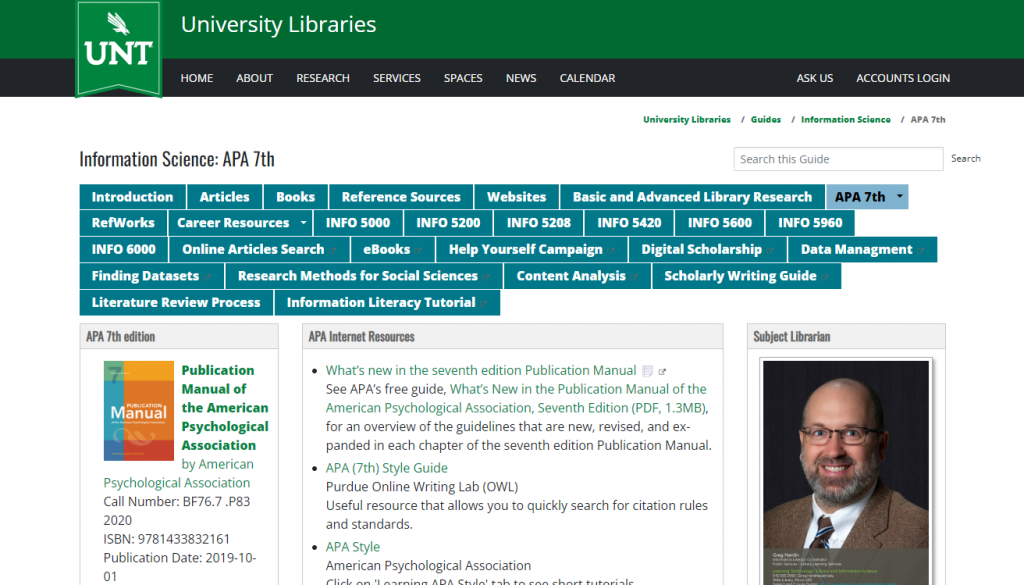Written by: Zoë (Abbie) Teel

Accessed from https://guides.library.unt.edu/lis/apa7th
Introduction
As the semester kicks off, the world of APA and references might be uncharted territory for many fellow students out there. Now, as a graduate student who’s been navigating the intricacies of APA ever since my high school days, I couldn’t help but whip up a nifty guide filled with all tips and tricks to master the art of APA in your papers.
Purpose of APA
The American Psychological Association emphasizes that using citations lays the groundwork for successful scholarly communication (APA, 2019). In academic settings, maintaining writer integrity and consistently acknowledging the originators of ideas are crucial aspects. It is all about giving credit and providing structure to a piece of writing.
Important to Know
When it comes to APA style, diving into the world of citations can feel like navigating a labyrinth where books, articles, journals, and other resources each have their unique set of guidelines.
At Willis Library, here at the University of North Texas, you can find a total of fourteen copies of the most recent (2020) edition of the Publication Manual of the American Psychological Association, which serves as the authoritative resource for APA style.
Within this manual, comprehensive explanations are provided for each specific aspect of APA style, including in-text citations and crafting references for the reference page. Through careful review, I have identified and highlighted what I consider to be the most prevalent and beneficial points for someone new to utilizing APA style.
Highlights
- Author Format:
- For one or more authors, list the last name followed by initials. Use an ampersand (&) before the last author’s name.
- Example: Teel, Z. A., & Lund, B. D.
- In-Text Citations:
- Include the author’s last name and publication year in parentheses.
- Example: (Teel & Wang, 2023).
- Reference Page:
- Begin with the word “References” centered at the top of a new page.
- List all sources alphabetically by the author’s last name.
- Arrange sources with identical last names based on their publication year.
- Italics:
- Italicize book and journal titles.
- Example: Title of Book or Title of Journal.
- Capitalization:
- Capitalize the first word of the title, subtitle, and proper nouns.
- Use sentence case for article and chapter titles.
- Example: The Art of Writing.
- On the reference page, journal articles should only have the first word capitalized, the following should all be lowercase.
- Example: “Information literacy, data literacy, privacy literacy, and chatgpt: technology literacies align with perspectives on emerging technology adoption within communities”
- URLs:
- Include the complete URL for online sources.
- Example: https://www.example.com.
- DOIs:
- Include the DOI (Digital Object Identifier) for sources with DOIs.
- Example: doi:10.12345/xyz.
- Book Citations:
- Author(s) Last Name, Initials. (Year). Title of Book. Publisher.
- Example: Teel, Z. A. (2023). The Science of Psychology. Academic Press.
- Journal Citations:
- Author(s) Last Name, Initials. (Year). Title of Article. Title of Journal, Volume(Issue), Page Range. DOI (if available).
- Example: Teel, Z. A. (2023). Understanding APA Citations. Journal of Psychology, 10(2), 123-145. doi:10.6789/abc123.
- Multiple Authors, Same Source:
- In the first citation, list all authors up to three. For more than three authors, use “et al.” after the first author’s name.
- Example: (Teel, Lund, & Wang, 2023) or (Teel et al., 2023).
- Same Author, Multiple Sources:
- Distinguish between multiple works by the same author and year with lowercase letters (a, b, c, etc.).
- Example: (Teel, 2023a) or (Teel, 2023b).
Overview Table (Condensed Information From Numbered List)
| Guidelines | Format & Example |
| Author Format | Teel, Z.A., & Lund, B.D. |
| In-Text Citations | (Teel & Wang, 2023) |
| Reference Page | References (the title at the top) centered |
| List sources alphabetically by author’s last name. | |
| Arrange sources with identical last names based on their publication year. | |
| Italics | Italicize book and journal titles |
| Example: Title of Book or Title of Journal | |
| Capitalization | Capitalize first word of title, subtitle, proper nouns |
| – Use sentence case for article and chapter titles | |
| Example: The Art of APA | |
| On reference page, only first word of journal article | |
| Example: “Information literacy, data literacy…” | |
| URLs | Include complete URL for online sources |
| Example: https://www.example.com | |
| DOIs | Include DOI (Digital Object Identifier) for sources |
| Example: doi:10.12345/xyz | |
| Book Citations | Author(s) Last Name, Initials. (Year). Title of Book. Publisher. |
| Example: Teel, Z. A. (2023). The Science of Psychology. Academic Press. | |
| Journal Citations | Author(s) Last Name, Initials. (Year). Title of Article. Title of Journal, Volume(Issue), Page Range. DOI (if available). |
| Example: Teel, Z. A. (2023). Understanding APA Citations. Journal of Psychology, 10(2), 123-145. doi:10.6789/abc123. | |
| Multiple Authors | List all authors up to three in first citation. For more than three, use “et al.” after first author’s name. |
| Example: (Teel, Lund, & Wang, 2023) or (Teel et al., 2023). | |
| Same Author, Multiple Sources | Distinguish between multiple works by the same author and year with lowercase letters (a, b, c, etc.). |
| Example: (Teel, 2023a) or (Teel, 2023b). |
Library Help & Conclusion
Learning the intricacies of APA formatting and style can greatly enhance the quality and professionalism of your academic work. To further assist you on your APA journey, consider utilizing the resources provided by the Purdue Owl, a highly recommended platform offering comprehensive APA Formatting and Style Guide overviews, an APA Style Introduction, and illustrative example papers. While the tips and tricks shared in this paper offer valuable insights, it’s worth noting that the UNT Libraries’ extensive LibGuide dedicated to APA serves as an invaluable resource. Greg Hardin, the subject librarian for this topic, stands ready to provide expert assistance. Additionally, the Writing Center offers access to APA manuals and a guide for correctly citing and formatting references in APA style, and appointments available both in person and online. By leveraging these tools and expert guidance, you can navigate the complexities of APA with confidence, ensuring your scholarly endeavors adhere to the highest standards of precision and clarity.
References
American Psychological Association. (2019). About APA Style. APA Style. https://apastyle.apa.org/about-apa-style



Leave a Reply